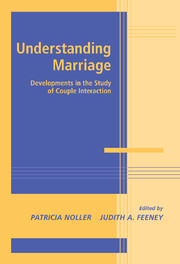Book contents
- Frontmatter
- Contents
- Contribitors
- Introduction
- SECTION ONE THE EFFECT OF COGNITION ON INTERACTION PATTERNS
- SECTION TWO UNDERSTANDING THE IMPORTANCE OF POSITIVE INTERACTION
- Introduction to Section Two
- 5 Observational “Windows” to Intimacy Processes in Marriage
- 6 Bases for Giving Benefits in Marriage: What Is Ideal? What Is Realistic? What Really Happens?
- 7 Shared Participation in Self-Expanding Activities: Positive Effects on Experienced Marital Quality
- SECTION THREE COPING WITH DISAPPOINTMENT, CRITICISM, AND BETRAYAL
- SECTION FOUR POWER, CONFLICT, AND VIOLENCE IN MARITAL INTERACTION
- Marital interaction at important transition periods
- SECTION SIX Interventions for strengthening relationships
- Conclusions
- Index
- References
5 - Observational “Windows” to Intimacy Processes in Marriage
Published online by Cambridge University Press: 25 July 2009
- Frontmatter
- Contents
- Contribitors
- Introduction
- SECTION ONE THE EFFECT OF COGNITION ON INTERACTION PATTERNS
- SECTION TWO UNDERSTANDING THE IMPORTANCE OF POSITIVE INTERACTION
- Introduction to Section Two
- 5 Observational “Windows” to Intimacy Processes in Marriage
- 6 Bases for Giving Benefits in Marriage: What Is Ideal? What Is Realistic? What Really Happens?
- 7 Shared Participation in Self-Expanding Activities: Positive Effects on Experienced Marital Quality
- SECTION THREE COPING WITH DISAPPOINTMENT, CRITICISM, AND BETRAYAL
- SECTION FOUR POWER, CONFLICT, AND VIOLENCE IN MARITAL INTERACTION
- Marital interaction at important transition periods
- SECTION SIX Interventions for strengthening relationships
- Conclusions
- Index
- References
Summary
Wife (W): There's lots of things I love about you … the way you laugh.
Husband (H): The whole package.
W: You look at me and you know what I'm thinking. The way you smile. The way your clothes are all over the house.
H: You don't love that. Don't lie.
W: No, but that's you, and I love you.
In the past two decades, researchers using behavioral observation methods to study marital functioning have focused almost exclusively on interaction processes related to conflict. As Fincham and Beach (1999) have noted, conflict processes have enjoyed a “privileged status” in marital interaction research. Negative affect and negative affect reciprocity have been established as robust correlates of marital discord (Gottman, 1998; Karney & Bradbury, 1995; Weiss & Heyman, 1990; for reviews). Distressed husbands and wives are more likely than their happily married counterparts to engage in hostile, blaming, and attacking behaviors, and further, they are more likely to reciprocate their partner's negative behavior. Although early behavioral theories of marital discord (for example, Birchler, Weiss, & Vincent, 1975; Jacobson & Margolin, 1979) explicitly acknowledged the functional role of positive behavioral transactions in successful marriages, the emphasis in recent years has been on the corrosive role of conflictual interactions in the development of marital dysfunction.
One reason for the current emphasis on negativity and conflict behavior may be the tremendous success of the problem-solving or “conflict” discussion task as a “window” to marital behavior.
- Type
- Chapter
- Information
- Understanding MarriageDevelopments in the Study of Couple Interaction, pp. 118 - 149Publisher: Cambridge University PressPrint publication year: 2002
References
- 14
- Cited by



